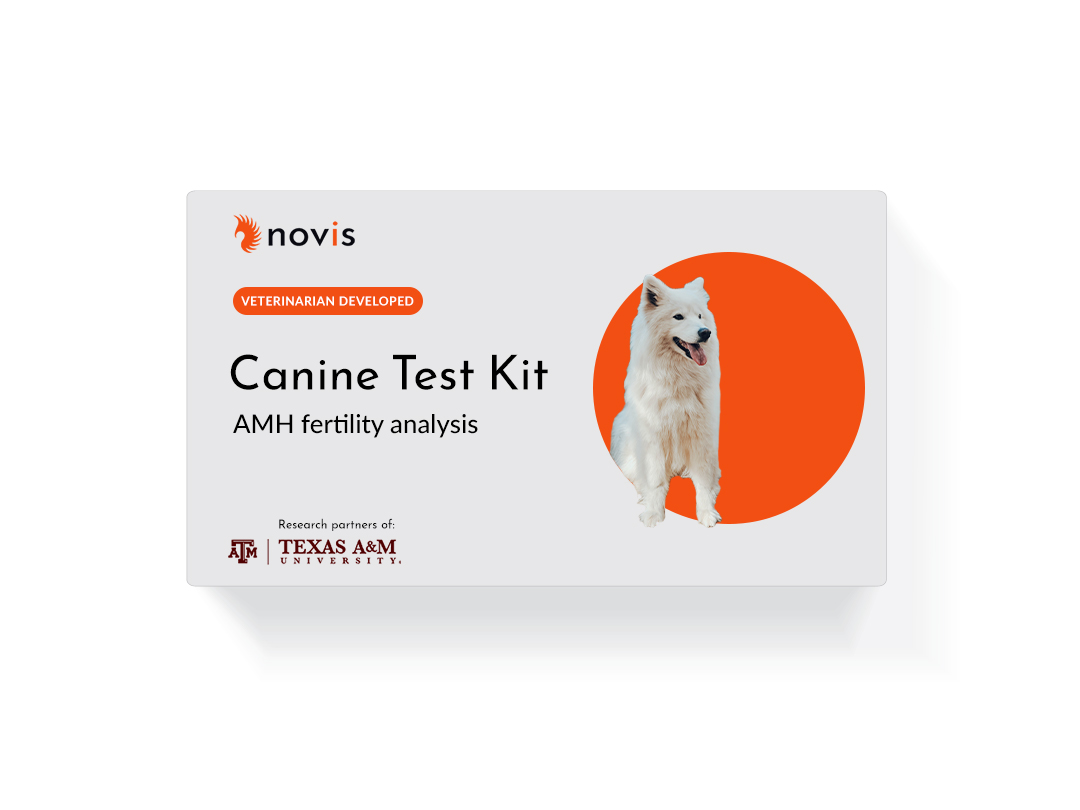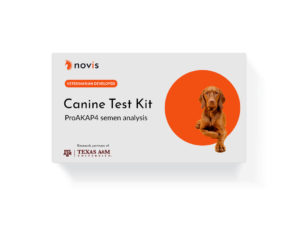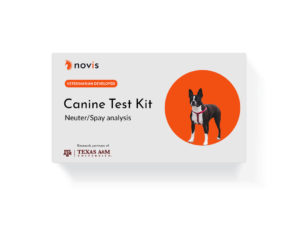The Serum AMH test is intended to be used as a qualifying biomarker for female canine fertility and a diagnostic tool in the determination of functional gonadal (spayed, neutered, or Intact) status in dogs.
What is canine AMH?
The anti-Müllerian hormone (AMH) is a member of the transforming growth factor β family of growth and differentiation factors 1. AMH is produced exclusively in testicular Sertoli cells and ovarian granulosa cells.
The physiological role of AMH in the two sexes is quite distinct 2,3. In males, AMH has an essential role in sex differentiation. The fetal and postnatal AMH production in males is used as a diagnostic marker to determine the presence of testicular tissue in the clinic. In post-pubertal males, AMH has a role in the regulation of testosterone production by the Leydig cells.
In females, AMH appears to have two roles in ovarian physiology. Firstly, AMH has a negative feedback effect on primordial follicles, i.e., it suppresses recruitment thereby signaling the presence of enough small growing follicles in the primordial follicle pool 3,8. Secondly, AMH suppresses the sensitivity of the follicle to FSH in an autocrine manner, preventing selection 9. As small follicles grow and differentiate, AMH starts to decrease when the differentiation state reaches the point when successful FSH selection is imminent, FSH sensitivity increases, and the follicle is selected.
Why is AMH in canines important?
In reproductive veterinary practices, the presence or absence of functional AMH serum levels in dogs has either been ignored or not known for canines, which is a challenge. In particular, when the reproductive success rates of dogs change, it may be difficult to ascertain all factors and variables that had an influence on the female’s side of the breeding.
Additionally, if the reproductive history of the animal is not known, it may be difficult to determine whether a female or male dog has been altered. In female dogs, the presence of remaining functional ovarian tissue after spaying is relevant when a presumably spayed animal is presented with clinical signs of AMH hormone activity. In addition, surgery performed at a
young age renders the visibility of surgical scars much more difficult. Serum AMH measurement can thus be used as a diagnostic tool in the determination of functional gonadal status in dogs.
AMH Applications:
- Female biomarker for fertility health
- Qualitative marker to monitor brood bitch longevity
- Qualifying marker to measure dietary/supplement impact on fertility potential
- Spay or neuter check-in male & female cndogsines
- Ovarian cyst presence
Scientific References:
- Place NJ, Hansen BS, Cheraskin JL, Cudney SE, Flanders JA, Newmark AD, Barry B, Scarlett JM 2011 Measurement of serum anti-Mullerian hormone concentration in female dogs and cats before and after ovariohysterectomy. J Vet Diagn Invest 23:524-527
- Olson PN, Mulnix JA, Nett TM 1992 Concentrations of luteinizing hormone and follicle-stimulating hormone in the serum of sexually intact and neutered dogs. American journal of veterinary research 53:762-766
- de Gier J, Buijtels JJ, Albers-Wolthers CH, Oei CH, Kooistra HS, Okkens AC 2012 Effects of gonadotropin-releasing hormone administration on the pituitary-gonadal axis in male and female dogs before and after gonadectomy. Theriogenology 77:967-978
- Buijtels JJ, Beijerink NJ, Kooistra HS, Dieleman SJ, Okkens AC 2006 Effects of gonadotrophin-releasing hormone administration on the pituitary-ovarian axis in anoestrous vs ovariectomized bitches. Reprod Domest Anim 41:555-561
- Teixeira J, Maheswaran S, Donahoe PK 2001 Mullerian inhibiting substance: An instructive developmental hormone with diagnostic and possible therapeutic applications. Endocr Rev 22:657-674
- Visser JA, Schipper I, Laven JS, Themmen AP 2012 Anti-Mullerian hormone: an ovarian reserve marker in primary ovarian insufficiency. Nature reviews Endocrinology 8:331-341
- Visser JA, de Jong FH, Laven JS, Themmen AP 2006 Anti-Mullerian hormone: a new marker for ovarian function. Reproduction 131:1-9
- Josso N 1986 Antimullerian hormone: new perspectives for a sexist molecule. Endocr Rev 7:421-433
- Rey R, Lordereau-Richard I, Carel JC, Barbet P, Cate RL, Roger M, Chaussain JL, Josso N 1993 Anti-mullerian hormone and testosterone serum levels are inversely during normal and precocious pubertal development. J Clin Endocrinol Metab 77:1220-1226
- HHS Publication, 5th ed., 2007. Biosafety in Microbiological and Biomedical Laboratories. Available http://www.cdc.gov/biosafety/publications/bmbl5/BMBL5
- DHHS (NIOSH) Publication No. 78–127, August 1976. Current Intelligence Bulletin 13 – Explosive Azide Hazard. Available http://www.cdc.gov/niosh.
- Approved Guideline – Procedures for the Handling and Processing of Blood Specimens, H18-A3. 2004. Clinical and Laboratory Standards Institute.
- Kricka L. Interferences in immunoassays – still a threat. Clin Chem 2000; 46: 1037–1038.



Reviews
There are no reviews yet.